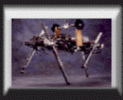Planar One-Leg Hopper (1980-1982)

The Planar One-Leg Hopper was built to explore active balance and
dynamic stability in legged locomotion. The machine has one leg that
changes length and pivots with respect to the body. The body carries
sensors, interface electronics, and the hip actuators. The machine was
powered by pneumatics.
Experiments with the Planar One-Leg Hopper showed that balance could be
achieved with a simple control system. The control system has three
separate parts: one controlling forward running speed, one controlling body
attitude, and one controlling hopping height. These controllers worked
independently, treating any coupling as disturbances. The control system
for the Planar One-Leg Hopper did not explicitely program a stepping
motion, but allowed the stepping motion to emerge under the constraints of
balance and controlled travel. The Planar One-Leg Hopper hopped in place,
travelled at specified rates, and maintained balance when disturbed. The
simple techniques used for planar one-leg hopper were later generalized for
3D one-leg hopping, bipedal running, and quadruped trotting, pacing, and
bounding.
Video
Publications
- Raibert, M. H. 1983. Dynamic stability and resonance in a one-legged
hopping machine. In Theory and Practice of Robots and Manipulators,
Proceedings of RoManSy'81, A. Morecki, G. Bianchi, K. Kedzior (eds.).
Warsaw: Polish Scientific Publishers. 352--367.
- Raibert, M. H. 1984. Hopping in legged systems---Modeling and simulation
for the 2D one-legged case. IEEE Trans. Systems, Man, and
Cybernetics 14:451--463.
- Raibert, M. H., Brown, H. B., Jr. 1984. Experiments in balance with a 2D
one-legged hopping machine. ASME J. Dynamic Systems, Measurement, and
Control 106:75--81.
- Raibert, M. H., Sutherland, I. E. 1983. Machines that walk.
Scientific American 248:44--53.
- Raibert, M. H., Wimberly, F. C. 1984. Tabular control of balance in a
dynamic legged system. IEEE Trans. Systems, Man, and Cybernetics
14:334--339.
- Raibert, M. H., Brown, H. B., Jr., Chepponis, M., Hastings, E., Shreve, S.
T., Wimberly, F. C. 1981. Dynamically Stable Legged Locomotion, First
Annual Report. CMU--RI--81--9, Robotics Institute, Carnegie-Mellon
University.
- Raibert, M. H., Brown, H. B., Jr., Chepponis, M., Hastings, E., Murthy, S.
S., Wimberly, F. C. 1983. Dynamically Stable Legged Locomotion--Second
Annual Report. CMU--RI--TR--83--1, Robotics Institute, Carnegie-Mellon
University.

 Back to the Leg Lab Home Page
Back to the Leg Lab Home Page
©
1995 MIT Leg Laboratory. All Rights Reserved.
Most recent update: 2/24/96

